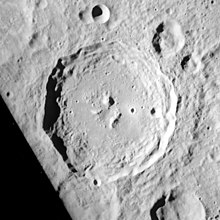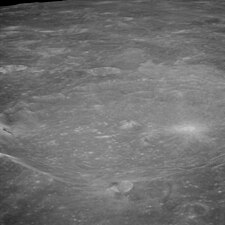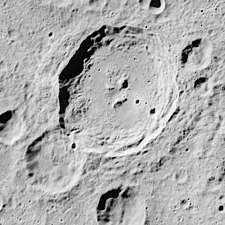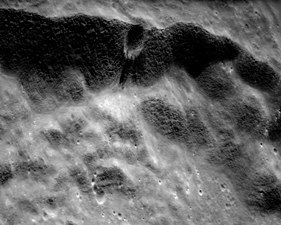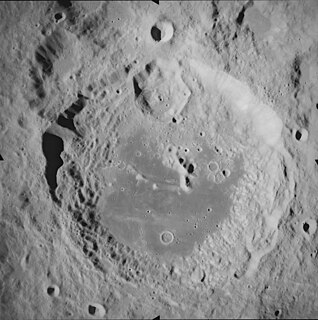
Aitken is a large lunar impact crater that lies on the far side of the Moon, named for Robert Grant Aitken, an American astronomer specializing in binary stellar systems. It is located to the southeast of the crater Heaviside, and north of the unusual formation Van de Graaff. Attached to the southwest rim is Vertregt. To the southeast is the smaller Bergstrand.

King is a prominent lunar impact crater that is located on the far side of the Moon, and can not be viewed directly from Earth. The crater was named after Arthur Scott King and Edward Skinner King in 1970. Prior to that, this crater was known as Crater 211. It forms a pair with Ibn Firnas, which is only slightly larger and is attached to the northeast rim of King. To the northwest is the crater Lobachevskiy, and Guyot is located an equal distance to the north-northwest.
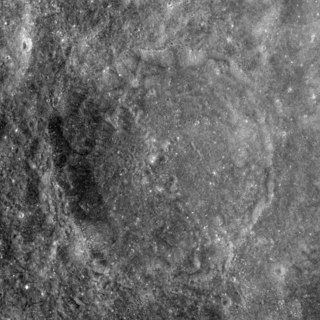
Vesalius is a lunar impact crater that lies on the far side of the Moon, less than 100 kilometers south of the lunar equator. It was named after Flemish anatomist and physician Andreas Vesalius. Just to the northwest is the slightly smaller crater Buisson. Farther to the west-southwest lies the prominent crater Einthoven.
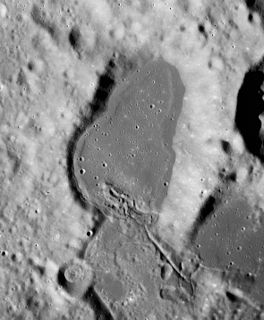
Bowditch is a lunar impact crater that lies on the far side of the Moon, just beyond the eastern limb. It is located on a region of the lunar surface that is brought into view due to libration, but at such times the area is viewed from the edge and so not much detail can be observed. It lies just to the north of the small Lacus Solitudinis lunar mare, between the craters Titius to the southwest and Perel'man to the east-northeast.
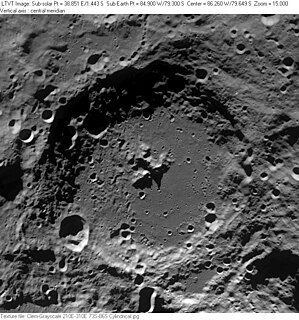
Drygalski is a large lunar impact crater that lies along the southern limb of the Moon. It partly overlies the crater Ashbrook to the west on the far side of the Moon. Just to the north of Drygalski is the smaller Boltzmann. The location of this crater restricts its observation from the Earth, and even under conditions of favorable libration it is viewed from the edge. It is only illuminated by the Sun at an oblique angle, and it lies close to the south polar craters that are permanently shielded from sunlight.

Hecataeus is a large lunar impact crater that lies near the eastern limb of the Moon. It is attached to the northern rim of the walled plain Humboldt. To the northeast is the smaller crater Gibbs. East of Hecataeus is a chain of small craters forming a line radial to Humboldt; these are designated the Catena Humboldt, named after the walled plain.

De Forest is a lunar impact crater on the far side of the Moon. It is located in the far southern hemisphere, to the west of the large walled plain Zeeman and due south of the crater Numerov. Because of its proximity to the southern pole, this crater receives sunlight at an oblique angle when it is on the illuminated half of the Moon.
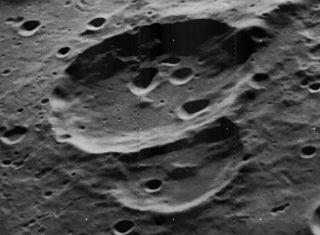
Chaffee is a lunar impact crater that is located in the southern hemisphere on the far side of the Moon. It lies within the huge walled plain Apollo, and is one of several craters in that formation named for astronauts and people associated with the Apollo program. This basin is a double-ringed formation, and the crater Chaffee is situated across the southwest part of the inner ring. The ridge from this ring extends northward from the northern rim of Chaffee.

Dryden is a lunar impact crater that is located on the southern hemisphere on the far side of the Moon. It lies within the huge walled plain called Apollo, and is one of several features within that basin named after people associated with the Apollo program. Apollo itself has an inner ring, and Dryden is attached to the west-northwest part of that circular mountain formation. To the south of Dryden along the same range is the crater Chaffee.
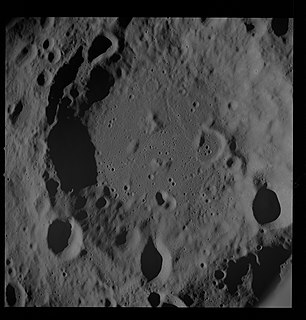
Coriolis is a lunar impact crater that is located on the far side of the Moon. The crater floor is bisected by the lunar equator, and it lies about three crater diameters northwest of the crater Daedalus.

Chaplygin is a large lunar impact crater that lies on the far side of the Moon. It is located to the southeast of the huge walled plain Mendeleev, about midway between the craters Schliemann to the northeast and Marconi to the southwest. It is about the same size as Albategnius on the near side.

Chauvenet is a lunar impact crater that is located to the northeast of the prominent crater Tsiolkovskiy on the far side of the Moon. Less than one crater diameter to the northwest of Chauvenet is the crater Ten Bruggencate.

Ibn Firnas is a lunar impact crater on the far side of the Moon. In 1976 it was named after Abbas Ibn Firnas, a polymath from Andalucia who, in the 9th century, devised a chain of rings that could be used to simulate the motions of the planets and stars.

Dobrovol'sky is a small lunar impact crater on the Moon's far side. The northwest part of its rim is intruded upon by the somewhat larger crater Shirakatsi, and the outer rampart of that feature covers most of the interior floor of Dobrovol'sky. Very little of the original floor now survives, with a small section near the southern inner wall. The remainder of the crater rim is somewhat circular and only mildly worn.
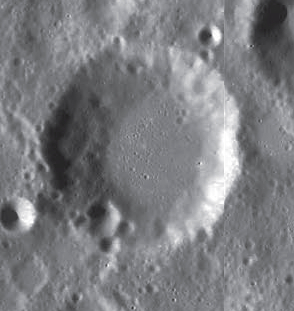
Dufay is a lunar impact crater that is located on the far side of the Moon. It lies about one crater diameter to the east of the large walled plain Mandel'shtam. To the northwest is the crater Papaleksi and to the east is Valier.

Firsov is a lunar impact crater on the far side of the Moon. It is located to due south of the crater Lobachevskiy, and to the northwest of Abul Wáfa. The circular rim of this crater has a small outward bulge along the southern edge, and smaller bulges along the western side. The inner walls have slumped to form talus piles along the base. The low-albedo interior floor is nearly level and featureless.

Galois is a large lunar impact crater on the far side of the Moon. Features of this class are commonly termed walled plains, due to their appearance and dimension. It is located just to the southeast of another huge walled plain, Korolev, a formation nearly double the diameter of Galois. Several hundred kilometers due south is another enormous feature, Apollo.
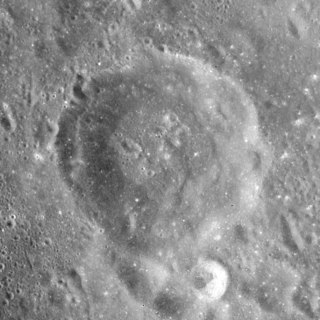
Ganskiy is a lunar impact crater that is located on the far side of the Moon. It lies to the southeast of the walled plain Hirayama.

Sklodowska (Skłodowska) is a large lunar impact crater that is located on the far side of the Moon. It lies just past the southeastern limb, and can sometimes be viewed from Earth under favorable conditions of libration and illumination. The crater is located to the northeast of the older walled plain Curie, and to the southwest of Pasteur, another walled plain.

Shirakatsi is an impact crater that is located on the Moon's far side. It is attached to the southern exterior rim of the larger crater Perepelkin, and overlies the northwestern rim of Dobrovol'skiy.
